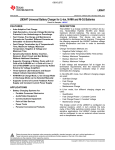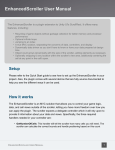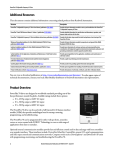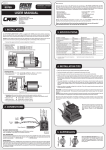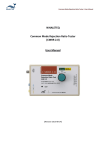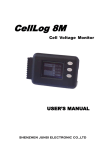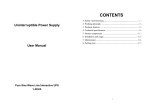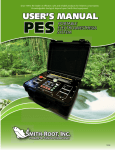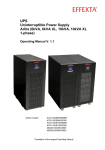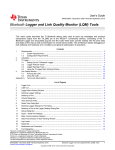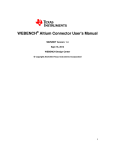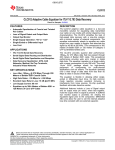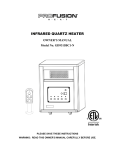Download AN-1164 LM3647 Reference Design User`s Manual (Rev. B)
Transcript
User's Guide SNVA023B – September 2000 – Revised May 2013 AN-1164 LM3647 Reference Design Demonstration Board 1 General Description The LM3647 is a charge controller for Nickel-Cadmium (Ni-Cd), Nickel-Metal Hydride (Ni-MH) or LithiumIon (Li-Ion) batteries. The device uses a pulsed-current charging or a constant-current charging technique. The device can also be configured to discharge before charging. Throughout the charging sequence the LM3647 monitors voltage and/or temperature and time in order to terminate charging. • Negative delta voltage (−ΔV) • Maximum voltage • Optional: Delta temperature/delta time (ΔT/Δt) • Optional: Maximum temperature • Backup: Maximum time The LM3647 is user configurable for three battery chemistries: Ni-Cd, Ni-MH or Li-Ion. 2 In • • • • Ni-Cd/Ni-MH mode, four different charging phases are used: Softstart charge Fast charge Topping charge Maintenance charge In • • • • Li-Ion mode, four different charging stages are used: Qualification Fast Charge Phase 1, Constant Current Fast Charge phase 2, Constant Voltage Maintenance charge Key Features • • • • • • • • • Auto-adaptive fast charge High-resolution, accurate voltage monitoring prevents Li-Ion under-charge or overcharge Fast charge, pre-charge and maintenance currents are provided. Different currents are selectable via external resistors Fast-charge termination by temperature/time, maximum voltage, maximum temperature and maximum time Dynamically detects battery insertion, removal, short circuit and bad battery without additional hardware Supports charging of battery packs with 2-8 cells of Ni-Cd, Ni-MH or 1-4 cells of Li-Ion Three LED indicators and one Buzzer output indicate operational modes Ni-MH/Ni-Cd charge mode, Li-Ion charge mode or discharge mode can be selected manually PWM switching controller SNVA023B – September 2000 – Revised May 2013 Submit Documentation Feedback AN-1164 LM3647 Reference Design Demonstration Board Copyright © 2000–2013, Texas Instruments Incorporated 1 Documentation Information 3 www.ti.com Documentation Information The following documentation describes how to use the LM3647 demo board and also gives a few tips on design calculations. Not all components on the demo board are used when designing a charger application. The demo board has extra components to make it simple for the user to try out different batteries and configurations. There are actually two different charge current regulation methods and these are referred to as fast and slow (LM317). 4 Jumper Settings J5 Type Select VCC Ni-MH GND Ni-Cd Hi-Z Li-Ion J2 Charge Mode VCC No discharge GND Maintenance charge only Hi-Z Discharge before charge J2 4.1 Maintenance Mode VCC Charge indefinitely GND No charge and restart fast-charge if battery becomes discharged Hi-Z Charge indefinitely and restart fast-charge if battery becomes discharged J5 J6 J7 Regulation Method / Cell Voltage VCC VCC GND Fast Slow LM3647 controls charge current External (LM317) charge control GND VCC GND Fast Slow LM3647 controls charge current External (LM317) charge control Hi-Z VCC GND Fast Fast 4.2V/Cell Li-Ion 4.1V/Cell Li-Ion Timeout Timeout settings J18 (set according to charge-rate C). 4.2 Temperature Input The optional Temperature input is connected to J3 and if not used Short J8. 4.3 Voltage Regulation Range Voltage regulation loop setting J14 (not used with external LM317 regulation; J7 = slow), defines maximum voltage output. See also Section 7. 4.4 Voltage Measurement The battery voltage is selected with the voltage jumpers J11 and J12 depending on number of cells/chemistry (see Figure 1). For instance, a 9V Ni-Cd block battery has 6 cells in it and therefore needs the jumper at "Ni 6-Cells" on J11 and J12: 2 AN-1164 LM3647 Reference Design Demonstration Board SNVA023B – September 2000 – Revised May 2013 Submit Documentation Feedback Copyright © 2000–2013, Texas Instruments Incorporated Jumper Settings www.ti.com Figure 1. Voltage Measurement 4.5 Charge Current The charge settings for LM3647 current control are shown below. If the external LM317 is used to control the charge current then the jumpers J9, J10 and J13 have no relevance, when using LM317 regulation mode, this jumper must be placed in either position. If external (LM317) regulation is used then set jumper J7 to position "slow"; for LM3647 regulation set J7 to "fast". 4.6 LM3647 Current Regulation The I jumper J10 is used to select between different current sense resistors. The values available are 0.047Ω and 0.100Ω (see Figure 2). Figure 2. Jumper J10 Selects Between Current Sense Resistors The charge current is set with jumpers J9 and J13. Figure 3 shows two possible currents that depend on how jumper J10 is set. The higher current is selected when J10 is set to 0.047Ω and the lower current is selected when J10 is set to 0.100Ω. Figure 3. Charge Current is Set with Jumpers J9 and J13 SNVA023B – September 2000 – Revised May 2013 Submit Documentation Feedback AN-1164 LM3647 Reference Design Demonstration Board Copyright © 2000–2013, Texas Instruments Incorporated 3 Functional Description 5 5.1 www.ti.com Functional Description General The LM3647 has voltage and current sensing inputs that are used to control a PWM-output. The voltage input is connected to the battery via a resistor divider network, and the current input is connected to an operational amplifier that amplifies the voltage across a current sense resistor located at the positive battery terminal. The PWM-output can be configured as a high-speed PWM, or as a low-speed (ON/OFF) output for an external current regulator. The latter is for low-cost Ni-Cd/Ni-MH charger applications, eliminating the need for any operational amplifiers or current feedback circuitry. The high-speed PWM is filtered to a DC-level and fed into an operational amplifier that controls a powerNPN transistor. The LM3467 requires charge current feedback to control the charge current. 5.2 5.2.1 Modes of Operation Charging Ni-Cd/Ni-MH Batteries The charger detects that a battery is connected when the CEL-pin > 1.0V. The charger can also detect a battery that has been deeply discharged and does not have any voltage across the battery terminals. This is accomplished by applying a small "pre-charge' current once every minute for up to 15 seconds. The deeply discharged battery will accept this charge and the battery potential will eventually rise above the 1.0V limit to initiate normal charging. When the charger has detected a battery (CEL-pin > 1.0V), it checks to see if the temperature is within range to start charging. If it is, then it applies a small current of 0.2C for approximately 5 minutes. If the battery voltage exceeds the maximum battery voltage (CEL-pin > 3.017V), the LM3647 stops charging and stays in error mode until the battery is removed. If the battery voltage has not risen above the bad battery threshold (CEL-pin < 1.2V), then the battery is considered to be defective and the charger goes into error mode. If the battery passes all tests, then after the five minutes have passed, the charger starts the next phase: Fast Charge. During Fast Charge, the charger applies a constant current to the battery and monitors both battery voltage and temperature. The charger is looking for a drop in the battery voltage that normally occurs at the end of the Fast Charge cycle. The size of the voltage drop differs depending on battery type (Ni-Cd/NiMH). For Ni-Cd it is approximately 50 mV/cell and for Ni-MH it is approximately 17 mV/cell. If the temperature rise is larger than 50 mV/minute (∼1°C/minute) when charging Ni-MH batteries, the battery has reached the end of the Fast Charge cycle. During charging the temperature-input is constantly measured to ensure that the battery's temperature is within proper range. If the temperature is out of range, the charger aborts the charge and goes into error mode. During the next charge phase (Topping Charge) the LM3647 applies a small current of 0.2C for a time set by the time-selection RC-network. This phase may be followed by a Maintenance Charge phase, depending on selection-pins. 5.2.2 Charging Li-Ion Batteries The charger detects that a battery is connected when the CEL-pin > 1.0V. The charger can also detect a battery that has been deeply discharged and does not have any voltage across the battery terminals. This is accomplished by applying a small "pre-charge" current once every minute for up to 15 seconds. The deeply discharged battery will accept this charge and the battery potential will eventually rise above the 1.0V limit to initiate normal charging. When the charger has detected a battery (CEL-pin > 1.0V), it checks to see if the temperature is within range to start charging. If it is, then it applies a small current of 0.2C for approximately 1 minute. If the battery voltage is close to fully charged, the charger will not reach the charging voltage within 1 minute, and the charge process will restart. This occurs only with batteries that are already fully charged, and consequently should not be recharged. If the battery voltage has not reached the Li-Ion battery qualification voltage (CEL-pin > 1.2V) within 1 minute of the Qualification Phase, the battery is considered to be defective, and the charger goes into error mode. It stays there until the battery is removed (CEL-pin < 1.0V). 4 AN-1164 LM3647 Reference Design Demonstration Board SNVA023B – September 2000 – Revised May 2013 Submit Documentation Feedback Copyright © 2000–2013, Texas Instruments Incorporated Functional Description www.ti.com The next phase is Fast Charge Constant Current. During this phase the current is constant, and the battery voltage will slowly rise (due to the charging). When the battery has reached its maximum battery voltage (CEL at 2.675V or 2.74V, depending on SEL3, it will go to the next phase which is Fast Charge Constant Voltage. During this phase, the charger will keep the voltage constant and stay in this phase until the current has decreased to a threshold value (CS at 2.3V). The battery is now fully charged, and the charger can behave in different modes, depending on SEL1. It can either maintenance charge the battery and restart the charge process if the battery voltage drops below the maintenance restart threshold value (CEL < 2.153V), or just maintenance charge the battery and don't restart the charge process if the battery becomes discharged. The last mode is no maintenance charge, and restarts the charge process if the battery voltage drops below the maintenance restart threshold value (CEL < 2.153V). 5.2.3 • • • • • • 5.2.4 Components Critical to Total Charger Performance The capacitance C2 connected to CEXT must be of a type that has low internal resistance, low loss, high stability and low dielectric absorption. The capacitance mounted on the demo board is a metallized polyester type from WIMA, 2220 series. The operational amplifiers U1 and U2 must be capable of rail-to-rail output, and have a high PSRR (Power Supply Rejection Ratio), because they are both powered directly from the unregulated DCinput. U1 must also have enough current drive to control the transistor Q3. U2 should preferably have a low input offset, since this error will be amplified. The regulator IC2 criteria is that it has to be able to handle the input DC-voltage, and deliver enough current to drive the circuitry (all LED's, buzzer, LM3647). The transistor Q3 must be able to handle the charge current and (depending on charge current) must be provided with an adequate heatsink. The transistor Q2 must be able to handle the maximum discharge current. The Diode D1 must be able to handle the maximum charge current. Clarifications Regarding Circuit Schematics The circuitry with Q4, R26 and R27 is used to protect the battery from excessive charge current. When the current flows through the current sense resistor R9, and is amplified by U2, the voltage at U2's output drops from 2.5V until Q4 starts conducting. It discharges the RC-network that generates the DC-voltage from the PWM-output of the LM3647. 5.2.5 Setting The Charge Timeout The LM3647 uses the charge timeout value as a backup termination method if the normal termination methods fail. The charge timeout also controls the length of some of the phases like the Topping Charge phase (Ni-Cd/Ni-MH). The timeout is selectable from a charge rate of 3.2C to 0.4C. Table 1 shows which values will result in a certain timeout. Table 1. Charge Timeouts R Value C Value Ni-Cd/Ni-MH Fast Charge (minutes) Ni-Cd/Ni-MH Topping (minutes) Li-lon CC (minutes) Li-lon CV (minutes) Appropriate Charge Rates 100 kΩ 0 nF 75 20 50 75 3.2C 100 kΩ 10 nF 100 25 70 100 2.4C 100 kΩ 15 nF 160 40 110 160 1.4C 100 kΩ 22 nF 190 50 130 190 1.2C 100 kΩ 33 nF 260 65 170 260 0.9C 100 kΩ 47 nF 330 80 220 330 0.7C 100 kΩ 68 nF 450 115 300 450 0.5C 100 kΩ 100 nF 540 135 360 540 0.4C SNVA023B – September 2000 – Revised May 2013 Submit Documentation Feedback AN-1164 LM3647 Reference Design Demonstration Board Copyright © 2000–2013, Texas Instruments Incorporated 5 Functional Description www.ti.com EXAMPLE 1: The actual timeouts (with RCIN @ 2.5 MHz) is: Phase Timeout Fast Charge ∼ 330 Minutes Topping Charge ∼ 80 Minutes EXAMPLE 2: The actual timeouts (with RCIN @ 2.5 MHz) is: Phase 5.2.6 Timeout Fast Charge Constant Current − 130 Minutes Topping Charge Constant Voltage − 190 Minutes Setting The Charge Current The charge-current is selected by setting the current sensing resistor and the gain of the differential amplification stage. The current sensing resistor (R5) should be dimensioned such that the voltage drop over it is not too small, since the signal will be more susceptible to noise and offsets in the amplificationstage. The resistance should not be too large either (especially in high-current applications), because this will only generate more heat from the component. A suitable value is one where 50 mV dropped across the resistor when maximum current flows through it. The differential signal is then amplified, inverted and centered around the 2.5V reference by the operational amplifier and fed to the CS pin on the LM3647. The gain must be dimensioned by setting the appropriate ratio between R1 (R2) and R3 (R4). Figure 4 is dimensioned for a maximum current of about 1.1A. This was dimensioned using the following formula: (1) 6 AN-1164 LM3647 Reference Design Demonstration Board SNVA023B – September 2000 – Revised May 2013 Submit Documentation Feedback Copyright © 2000–2013, Texas Instruments Incorporated Functional Description www.ti.com Figure 4. Setting the Chart Current 5.2.7 Setting Maximum Battery Voltage The resistor network (see Figure 5) scales the battery voltage to a suitable level for the LM3647. For NiCd/Ni-MH batteries the network is less critical, but limits the maximum battery voltage, it is only used as a backup termination method. For Li-Ion batteries the network must be more accurate, requiring precision resistors with low tolerances. • For Ni-Cd/Ni-MH: The dimensioning is accomplished in the following manner: First calculate the maximum battery voltage for the specific battery pack. See the example below. BatteryVoltage/Cell = 1.2V NumberOfCells = 5 → BatteryPackVoltage = 1.2×5 = 6V MaximumBatteryVoltage/Cell = 1.85V → MaximumBatteryVoltage = 1.85×5 = 9.25V (2) (3) When the Maximum Battery Voltage has been determined, the voltage divider network has to be dimensioned using the following formula: Figure 5. Maximum Battery Voltage • For Li-Ion: SNVA023B – September 2000 – Revised May 2013 Submit Documentation Feedback AN-1164 LM3647 Reference Design Demonstration Board Copyright © 2000–2013, Texas Instruments Incorporated 7 Functional Description www.ti.com The voltage divider network for Li-Ion is very important. If the battery voltage is scaled too low, the battery will not attain its full capacity when charged, and if scaled too high, the battery may become damaged. Never exceed the recommended maximum voltage or current for a Li-Ion battery! The dimensioning is done in the following manner. First calculate the maximum battery voltage for the specific battery pack. See example below. BatteryVoltage/Cell = 3.6V NumberOfCells = 2 → BatteryPackVoltage = 3.6×2 = 7.2V MaximumBatteryVoltage/Cell = 4.1V → MaximumBatteryVoltage = 4.1×2 = 8.2V (4) (5) When the maximum battery voltage has been determined, the voltage divider network has to be dimensioned using the following formula: (6) The LM3647 has two different regulation voltages, which the user can select: the 2.675V (SEL3 tied to GND) and 2.740V (SEL3 tied to VCC). This selection pin can be used to configure the charger to regulate for different input voltages so that the charger can handle both 3.6V- and 3.7V-cells, without changing the resistor values in the divider network. SEL3 can also be used if there is problem in finding the right values in the resistor network. The recommended tolerance of the resistors are 0.1%, but 1% may be used with a marginal loss of battery capacity by subtracting the tolerance of the divider network from the maximum battery voltage. • Using the LM3647 without current feedback, for Ni-Cd/Ni-MH only (slow PWM mode): This mode uses an external constant-current power-source, which is switched on and off according to the charge-phase of the LM3647. The frequency is approximately 0.1 Hz. The advantage of this charge method is that operational amplifiers and the current feedback circuitry are not needed, which provides a low-cost solution. The dimensioning of the voltage divider network is performed the same way. The constant current source is dimensioned in the following manner: (7) Figure 6. LM3647 Regulator The LM3647 regulates the constant current source by turning the transistor Q1 on and of (see Figure 6). When the transistor is off, the LM317T regulator feeds a constant current to the battery (at V_OUT). When the transistor is on, the output from the LM317 is limited to 1.25V (which should be greater than the battery voltage). Charge Phase: 8 Duty Cycle: Soft Start 10% Fast Charge 100% Topping Charge 10% Maintenance Charge 5% AN-1164 LM3647 Reference Design Demonstration Board SNVA023B – September 2000 – Revised May 2013 Submit Documentation Feedback Copyright © 2000–2013, Texas Instruments Incorporated Application information www.ti.com 6 6.1 Application information Typical Example 6.1.1 Ni-Cd/Ni-MH Figure 7. Set To: Ni-Cd/Ni-MH SEL1 SEL2 SEL3 VCC No Discharge before Charge Ni-MH Fast-PWM (LM3647 has current feedback) Hi-Z Discharge before Charge NA NA GND Maintenance Charge Only Ni-Cd Slow-PWM (external current control) SNVA023B – September 2000 – Revised May 2013 Submit Documentation Feedback AN-1164 LM3647 Reference Design Demonstration Board Copyright © 2000–2013, Texas Instruments Incorporated 9 Application information 6.2 www.ti.com Li-Ion Figure 8. Li_ION Set To: SEL1 SEL2 SEL3 VCC After charging, maintenance charging until battery removal. NA 4.2V/Cell Hi-Z After charging, maintenance charging until battery removal. If battery voltage drops below a predefined value, the charger restarts the charge-process. Li-Ion NA GND After charging, no maintenance charging is applied. If battery voltage drops below a predefined value, the charger restarts the charge-process. NA 4.1V/Cell NOTE: When a three chemistry charger is designed, special considerations must be taken into account regarding configuration pin SEL3. This pin has different meanings when switching between Ni-Cd/Ni-MH and Li-Ion. To ensure correct operation, the SEL3-pin MUST be tied to VCC. If Li-Ion cells of 4.1V/Cells are used, then minor adjustments have to be done to the voltage measurement resistor divider. 10 AN-1164 LM3647 Reference Design Demonstration Board SNVA023B – September 2000 – Revised May 2013 Submit Documentation Feedback Copyright © 2000–2013, Texas Instruments Incorporated LM3647 Reference Design Demonstration Board www.ti.com 7 LM3647 Reference Design Demonstration Board The demo board provides a combined multi-chemistry solution with hardware for both external constant current source and LM3647 controlled charge current. Located near the top-left corner of the board is the power supply connector (next to the heatsink). When using the external constant current source, a power resistor needs to be connected at the connector marked 317-resistor. The values of the resistor can be calculated using the Equation 4 mentioned earlier. At the bottom-right corner of the board are two connectors that lead to the battery and discharge resistor. The value of the discharge resistor depends on the battery pack voltage and the maximum discharge rate. The demo board has different jumpers that are assigned to different setups. Some of the components are not populated, providing support for user-specific values. The timeout jumper J18 is used to select different timeouts from 2.4C to 0.4C. The values mounted on the demo board result in timeouts corresponding to the charge-rates shown in Figure 9. Figure 9. Timeout Jumper J18 Used to Select Different Timeouts From 2.4C to 0.4C The PWM jumper J7 is used to connect the PWM-signal to either the external constant current source (marked slow) or the RC-filter that is connected to the operational amplifier (marked fast). The PWM-FB jumper J14 is used to select different amplification levels of the PWM signal. The jumper with the battery voltage ranges are shown below: Figure 10. PWM-FB Jumper J14 Used to Select Different Amplification Levels of the PWM Signal The I jumper J10 is used to select between different current sense resistors. The values mounted are 0.047Ω and 0.100Ω. Figure 11. Jumper J10 Used to Select Between Different Current Sense Resistors SNVA023B – September 2000 – Revised May 2013 Submit Documentation Feedback AN-1164 LM3647 Reference Design Demonstration Board Copyright © 2000–2013, Texas Instruments Incorporated 11 LM3647 Reference Design Demonstration Board www.ti.com The different current sense voltage amplification level is selected via CURRENT jumpers J9 and J13 (both jumpers must be changed in pairs, see Figure 12). The upper values correspond to a current sense resistor of 0.047Ω while the lower correspond to 0.100Ω (see Figure 11). Figure 12. CURRENT Jumpers J9 and J13 The battery voltage is selected with the Voltage jumpers J11 and J12 (see Figure 13 for settings). Figure 13. Voltage Jumpers 11 and 12 The jumper J3 is used to connect to an optional NTC-resistor. If no temperature sensor is used, the jumper J8 must be shorted (see Figure 14) . The demo board was designed for an NTC thermistor from Siemens (B57861S302F40) with the following specifications: 3kΩ @ 25°C, β = 3988. If an NTC with different characteristics is used, then the resistor R28 may need to be changed. The charger uses voltage levels to trigger under/over temperature conditions. The voltage at the temperature-input must be between 2.2V or 0.5V for the charger to start. During charging the voltage must stay between 3.0V for Li-Ion, or 3.15V for Ni-Cd/Ni-MH, and 0.5V or the charger will register a temperature fault and abort the charge. Figure 14. Jumper J3 or Jumper 8 12 AN-1164 LM3647 Reference Design Demonstration Board SNVA023B – September 2000 – Revised May 2013 Submit Documentation Feedback Copyright © 2000–2013, Texas Instruments Incorporated LM3647 Reference Design Demonstration Board www.ti.com Figure 15. Voltage Temperature The three jumpers J2, J5, and J6 are connected to the three selection-pins SEL1, SEL2, and SEL3. These jumpers are used to select how the charger should behave (see Table 1). Figure 16. Jumpers J2, J5, and J6 Connected to 3 Selection Pins SEL1, SEL2, and SEL3 SNVA023B – September 2000 – Revised May 2013 Submit Documentation Feedback AN-1164 LM3647 Reference Design Demonstration Board Copyright © 2000–2013, Texas Instruments Incorporated 13 IMPORTANT NOTICE Texas Instruments Incorporated and its subsidiaries (TI) reserve the right to make corrections, enhancements, improvements and other changes to its semiconductor products and services per JESD46, latest issue, and to discontinue any product or service per JESD48, latest issue. Buyers should obtain the latest relevant information before placing orders and should verify that such information is current and complete. All semiconductor products (also referred to herein as “components”) are sold subject to TI’s terms and conditions of sale supplied at the time of order acknowledgment. TI warrants performance of its components to the specifications applicable at the time of sale, in accordance with the warranty in TI’s terms and conditions of sale of semiconductor products. Testing and other quality control techniques are used to the extent TI deems necessary to support this warranty. Except where mandated by applicable law, testing of all parameters of each component is not necessarily performed. TI assumes no liability for applications assistance or the design of Buyers’ products. Buyers are responsible for their products and applications using TI components. To minimize the risks associated with Buyers’ products and applications, Buyers should provide adequate design and operating safeguards. TI does not warrant or represent that any license, either express or implied, is granted under any patent right, copyright, mask work right, or other intellectual property right relating to any combination, machine, or process in which TI components or services are used. Information published by TI regarding third-party products or services does not constitute a license to use such products or services or a warranty or endorsement thereof. Use of such information may require a license from a third party under the patents or other intellectual property of the third party, or a license from TI under the patents or other intellectual property of TI. Reproduction of significant portions of TI information in TI data books or data sheets is permissible only if reproduction is without alteration and is accompanied by all associated warranties, conditions, limitations, and notices. TI is not responsible or liable for such altered documentation. Information of third parties may be subject to additional restrictions. Resale of TI components or services with statements different from or beyond the parameters stated by TI for that component or service voids all express and any implied warranties for the associated TI component or service and is an unfair and deceptive business practice. TI is not responsible or liable for any such statements. Buyer acknowledges and agrees that it is solely responsible for compliance with all legal, regulatory and safety-related requirements concerning its products, and any use of TI components in its applications, notwithstanding any applications-related information or support that may be provided by TI. Buyer represents and agrees that it has all the necessary expertise to create and implement safeguards which anticipate dangerous consequences of failures, monitor failures and their consequences, lessen the likelihood of failures that might cause harm and take appropriate remedial actions. Buyer will fully indemnify TI and its representatives against any damages arising out of the use of any TI components in safety-critical applications. In some cases, TI components may be promoted specifically to facilitate safety-related applications. With such components, TI’s goal is to help enable customers to design and create their own end-product solutions that meet applicable functional safety standards and requirements. Nonetheless, such components are subject to these terms. No TI components are authorized for use in FDA Class III (or similar life-critical medical equipment) unless authorized officers of the parties have executed a special agreement specifically governing such use. Only those TI components which TI has specifically designated as military grade or “enhanced plastic” are designed and intended for use in military/aerospace applications or environments. Buyer acknowledges and agrees that any military or aerospace use of TI components which have not been so designated is solely at the Buyer's risk, and that Buyer is solely responsible for compliance with all legal and regulatory requirements in connection with such use. TI has specifically designated certain components as meeting ISO/TS16949 requirements, mainly for automotive use. In any case of use of non-designated products, TI will not be responsible for any failure to meet ISO/TS16949. Products Applications Audio www.ti.com/audio Automotive and Transportation www.ti.com/automotive Amplifiers amplifier.ti.com Communications and Telecom www.ti.com/communications Data Converters dataconverter.ti.com Computers and Peripherals www.ti.com/computers DLP® Products www.dlp.com Consumer Electronics www.ti.com/consumer-apps DSP dsp.ti.com Energy and Lighting www.ti.com/energy Clocks and Timers www.ti.com/clocks Industrial www.ti.com/industrial Interface interface.ti.com Medical www.ti.com/medical Logic logic.ti.com Security www.ti.com/security Power Mgmt power.ti.com Space, Avionics and Defense www.ti.com/space-avionics-defense Microcontrollers microcontroller.ti.com Video and Imaging www.ti.com/video RFID www.ti-rfid.com OMAP Applications Processors www.ti.com/omap TI E2E Community e2e.ti.com Wireless Connectivity www.ti.com/wirelessconnectivity Mailing Address: Texas Instruments, Post Office Box 655303, Dallas, Texas 75265 Copyright © 2013, Texas Instruments Incorporated
















